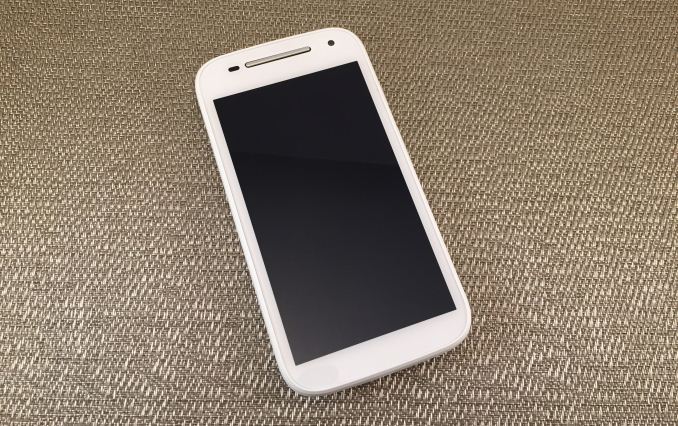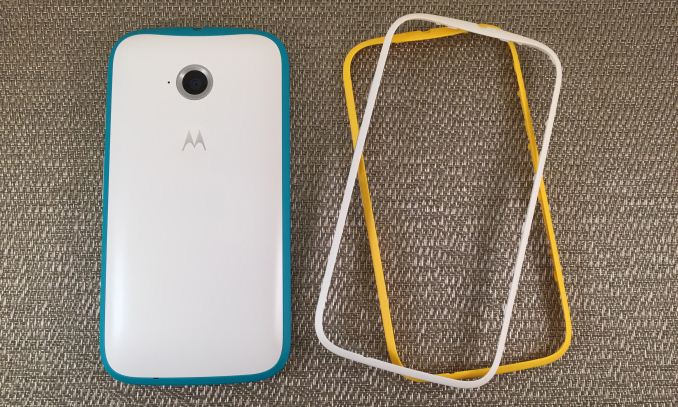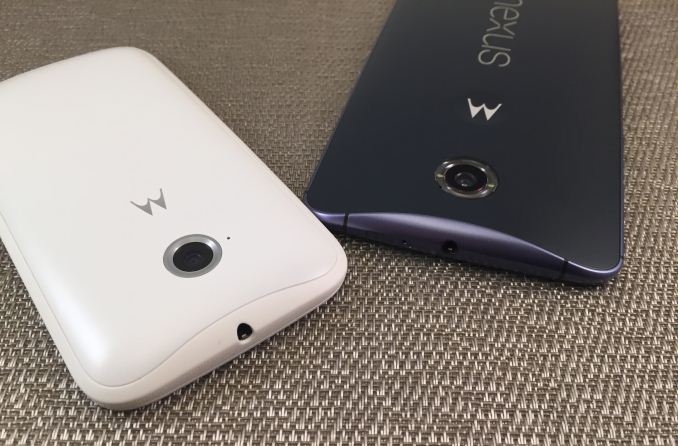The Moto E (2015) Review
by Brandon Chester on April 21, 2015 8:00 AM EST- Posted in
- Smartphones
- Motorola
- Mobile
- Moto E (2015)

During the past couple of years we've seen a dramatic shift in Motorola's strategy for competing in the smartphone market. As one of the earliest producers of Android devices, the company needed to let go of ideas and strategies from years that had since past. Producing exclusive devices for carriers like Verizon was no longer going to work with the iPhone finally freed from exclusivity on AT&T, and Motorola's hardware and software design had begun to show a great deal of age.
That brings us to today, at a point where Motorola has more or less found their new approach to making smartphones. It's a very simple and understandable approach. Consistency across the design of the hardware, consistency across the design of the software, and a yearly line of phones that can easily be divided into budget, mid-range, and flagship categories based on a single letter in their name. This review takes a look at the newest version of Motorola's budget device, the 2015 Moto E. Unfortunately, this year adds a bit of complexity to the simplicity of Motorola's smartphone line. Before getting into that, I've put the general specifications of the new Moto E below, with the original 2014 model as a point of comparison.
| Motorola Moto E (2015) (LTE model XT1527) |
Motorola Moto E (2015) (3G models) |
Motorola Moto E (2014) | |
| SoC | Qualcomm Snapdragon 410 (MSM8916) 4x Cortex A53 @ 1.2GHz Adreno 306 at 400MHz |
Qualcomm Snapdragon 200 (MSM8x10) 4x Cortex A7 @ 1.2GHz Adreno 302 at 400MHz |
Qualcomm Snapdragon 200 (MSM8x10) 2x Cortex A7 @ 1.2GHz Adreno 302 at 400MHz |
| RAM | 1 GB LPDDR3 | 1GB LPDDR2 | |
| NAND | 8GB NAND + microSD | 4GB NAND + microSD | |
| Display | 4.5” 960x540 IPS LCD | 4.3" 960x540 IPS LCD | |
| Network | 2G / 3G / 4G LTE (Qualcomm MDM9x25 UE Category 4 LTE) | 2G / 3G HSPA+ (MDM8x10) | 2G / 3G HSPA+ (MDM8x10) |
| Dimensions | 129.9 x 66.8 x 12.3mm 145g |
124.38 x 64.8 x 12.3mm 142g |
|
| Camera | 5MP (2592 х 1944) Rear Facing w/Auto Focus, F/2.2 aperture VGA (640x480) Front Facing |
5MP (2592 х 1944) Rear Facing w/Fixed Focus | |
| Battery | 2390 mAh (9.08Wh) | 1980 mAh (7.52Wh) | |
| OS | Android 5.0 | Android 4.4.2 | |
| Connectivity | 802.11 b/g/n + BT 4.0, USB2.0, GPS/GNSS | ||
| SIM Size | Micro-SIM | ||
On the cellular side, we have two HSPA models and 1 LTE model of the Moto E. There is an LTE version with UMTS bands targeted at the US market, a 3G-only version for the US market, and a global 3G version. The difference between the US and global 3G bands is the inclusion of the 1700MHz band for T-Mobile support on the US version, and the 900/2100MHz bands on the global version.
Design
Over the past couple of years, Motorola's hardware and software design has undergone some enormous changes. They shifted from producing heavily skinned and modified Android devices to using almost stock Google Android. Their industrial design similarly underwent significant changes, and a new style for their smartphones emerged with the original Moto X in 2013. The flat sides and edges of Motorola's old phones were replaced with continuous curves. This type of design is not only more ergonomic than Motorola's old devices, but also more unique and recognizable. It's very clear from the appearance of a Motorola phone that it is a Motorola phone, even without spotting the depressed logo on the back cover.
The Moto E is no exception to Motorola's industrial design. The back cover has a continuous curve that extends to all corners and meets with the phone's arched sides. The back of the phone has only a center-aligned 5MP camera and Motorola's standard indented logo. Unlike the original Moto E this back cover is no longer removable and customizable with different colors. Since the Moto E is a budget device, it also can't be customized with Motorola's Moto Maker. To add a level of personalization, Motorola has designed the phone so that the band around the edges is removable. Users can purchase a set of red, blue, and yellow bands for $20, and can swap them out with the default white or black bands as they please.
The band being removable creates a potential concern about the usability of the Moto E's buttons, as the part that you press down on is integrated into the bands themselves. During my time with the device I was actually surprised by how tactile the buttons felt and how little they wobbled considering that they were completely separated from the actual button mechanism. They definitely had more of a mushy feeling than the buttons on the Nexus 6, but they were still completely usable and actually better than I expected.
The removable bands also act as a great way to hide many of the ports on the device. Removing the band allows access to the Moto E's MicroSD slot and Micro-SIM port. The SIM slot is spring loaded, but it's so deep that anyone without very long nails will end up having to use a small object to press on the end of the SIM to remove it anyway.
The left side of the device has a tag which is attached internally and has FCC and regulatory information on it, as well as the device's IMEI.
I'm quite happy with the direction Motorola has gone in with regards to design. The basic design of a Motorola phone scales down to $150 devices and all the way up to $700 devices, and on all of them it's visually appealing as well as ergonomic. The material quality definitely takes a step down when you go for those budget devices, with the Moto E sporting a plastic outer band instead of the metal ones on the Moto X and Nexus 6. Despite that, the phone still feels well made and the matte plastic back actually feels just as nice as the one on the Nexus 6. If anything, Motorola might want to worry about their flagship devices not offering enough of an improvement over the very good build quality and materials of their budget offerings.













90 Comments
View All Comments
Impulses - Tuesday, April 21, 2015 - link
It looks very similar to the rest of Moto's lineup... You think the Moto X & G are fugly too? How many people have you polled to determine the majority definitely agrees with you?I happen to like how it looks, actually Moto's rounded plastic phones are some of the few I would dare use without a case... Both because they seem more resilient than metal ones and because the customization aspect makes it more unique.
I remember noticing a lip on the Moto X that actually lifted the screen by a mm when face down sans case, not sure if that's standard, but that and lack of a camera hump also make it easier to go case-less.
For reference I like the new SGS6 (tho I still dislike the home button) and Sony's Z line, I could take or leave the One design (poor ergos), and I thought older SGS with plastic imitating other materials was chintzy.
At the end of the day I care more about a phone's features, performance, and ergonomics than it's looks tho. None of them are *that* striking or stylish.
chizow - Tuesday, April 21, 2015 - link
Sure, here you go, the same tenets apply to smartphones as they do to people's faces:https://www.google.com/?gws_rd=ssl#q=symmetrical+f...
Its been shown whether subconsciously or not, the more symmetrical a face is, the more pleasing it is to the eye.
The rounded and concave edges just make it look like a cheap toy, too much round around the sharp angles of the rectangular screen and the asymmetrical nature of the speakers and cameras don't do it any favors either.
blzd - Thursday, April 23, 2015 - link
Well that settles it. 100% Confirmed. Everyone agrees with you.lol please do the world a favor and delete your internet.
hans_ober - Tuesday, April 21, 2015 - link
If it's anything, wide bezels make devices ugly.sonicmerlin - Wednesday, April 22, 2015 - link
lol that was my first thought upon seeing the picture. It looks like a half-done prototype. The Lumias going for half the price look better.DabuXian - Tuesday, April 21, 2015 - link
Off topic, but why don't you update NAND performance of the Nexus 6? It's been vastly improved on Android 5.1.Brandon Chester - Tuesday, April 21, 2015 - link
Our NAND tests are being moved to Androbench 4. The writing of this review took place over a longer period than I had anticipated, which is why there are a few things like the usage of the older NAND bench and the GS6 not showing up in the charts. In future reviews the Nexus 6 should have up to date storage performance benchmarks done on 5.1.djvita - Tuesday, April 21, 2015 - link
The graph for Basemark OS II battery score is missing the Moto E's score.whiteiphoneproblems - Tuesday, April 21, 2015 - link
"The procedure for iOS is a bit different, and it involves signing into your iCloud account which I'm just a bit weary of..."Should be "...just a bit WARY of".
Also, I don't see the Moto E listed on the "Basemark OS II Battery Score" chart(?)
whiteiphoneproblems - Tuesday, April 21, 2015 - link
(Apologies for x-post with the above)